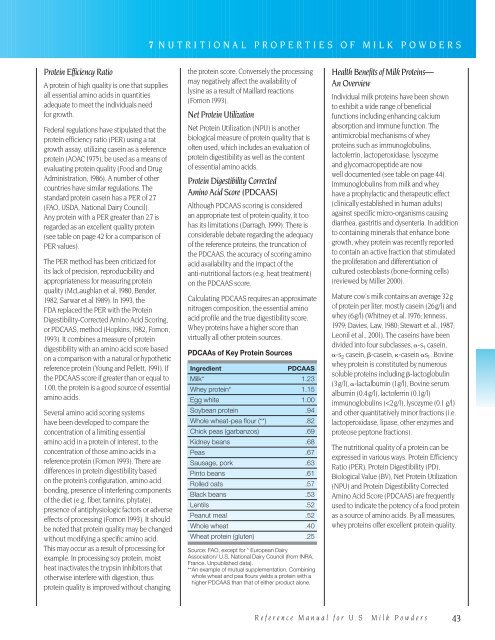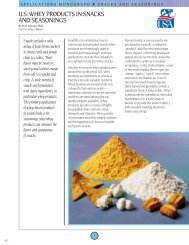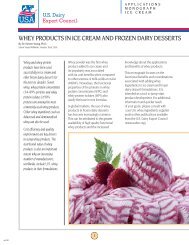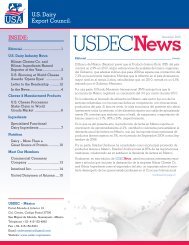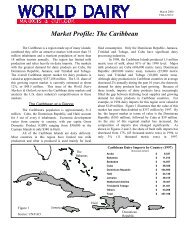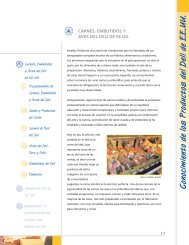nutritional properties of milk powders - US Dairy Export Council
nutritional properties of milk powders - US Dairy Export Council
nutritional properties of milk powders - US Dairy Export Council
You also want an ePaper? Increase the reach of your titles
YUMPU automatically turns print PDFs into web optimized ePapers that Google loves.
7 NUTRITIONAL PROPERTIES OF MILK POWDERS<br />
Protein Efficiency Ratio<br />
A protein <strong>of</strong> high quality is one that supplies<br />
all essential amino acids in quantities<br />
adequate to meet the individuals need<br />
for growth.<br />
Federal regulations have stipulated that the<br />
protein efficiency ratio (PER) using a rat<br />
growth assay, utilizing casein as a reference<br />
protein (AOAC 1975), be used as a means <strong>of</strong><br />
evaluating protein quality (Food and Drug<br />
Administration, 1986). A number <strong>of</strong> other<br />
countries have similar regulations. The<br />
standard protein casein has a PER <strong>of</strong> 2.7<br />
(FAO, <strong>US</strong>DA, National <strong>Dairy</strong> <strong>Council</strong>).<br />
Any protein with a PER greater than 2.7 is<br />
regarded as an excellent quality protein<br />
(see table on page 42 for a comparison <strong>of</strong><br />
PER values).<br />
The PER method has been criticized for<br />
its lack <strong>of</strong> precision, reproducibility and<br />
appropriateness for measuring protein<br />
quality (McLaughlan et al, 1980, Bender,<br />
1982, Sarwar et al 1989). In 1993, the<br />
FDA replaced the PER with the Protein<br />
Digestibility-Corrected Amino Acid Scoring,<br />
or PDCAAS, method (Hopkins,1982, Fomon,<br />
1993). It combines a measure <strong>of</strong> protein<br />
digestibility with an amino acid score based<br />
on a comparison with a natural or hypothetic<br />
reference protein (Young and Pellett, 1991). If<br />
the PDCAAS score if greater than or equal to<br />
1.00, the protein is a good source <strong>of</strong> essential<br />
amino acids.<br />
Several amino acid scoring systems<br />
have been developed to compare the<br />
concentration <strong>of</strong> a limiting essential<br />
amino acid in a protein <strong>of</strong> interest, to the<br />
concentration <strong>of</strong> those amino acids in a<br />
reference protein (Fomon 1993). There are<br />
differences in protein digestibility based<br />
on the protein’s configuration, amino acid<br />
bonding, presence <strong>of</strong> interfering components<br />
<strong>of</strong> the diet (e.g. fiber, tannins, phytate),<br />
presence <strong>of</strong> antiphysiologic factors or adverse<br />
effects <strong>of</strong> processing (Fomon 1993). It should<br />
be noted that protein quality may be changed<br />
without modifying a specific amino acid.<br />
This may occur as a result <strong>of</strong> processing for<br />
example. In processing soy protein, moist<br />
heat inactivates the trypsin inhibitors that<br />
otherwise interfere with digestion, thus<br />
protein quality is improved without changing<br />
the protein score. Conversely the processing<br />
may negatively affect the availability <strong>of</strong><br />
lysine as a result <strong>of</strong> Maillard reactions<br />
(Fomon 1993).<br />
Net Protein Utilization<br />
Net Protein Utilization (NPU) is another<br />
biological measure <strong>of</strong> protein quality that is<br />
<strong>of</strong>ten used, which includes an evaluation <strong>of</strong><br />
protein digestibility as well as the content<br />
<strong>of</strong> essential amino acids.<br />
Protein Digestibility Corrected<br />
Amino Acid Score (PDCAAS)<br />
Although PDCAAS scoring is considered<br />
an appropriate test <strong>of</strong> protein quality, it too<br />
has its limitations (Darragh, 1999). There is<br />
considerable debate regarding the adequacy<br />
<strong>of</strong> the reference proteins, the truncation <strong>of</strong><br />
the PDCAAS, the accuracy <strong>of</strong> scoring amino<br />
acid availability and the impact <strong>of</strong> the<br />
anti-<strong>nutritional</strong> factors (e.g. heat treatment)<br />
on the PDCAAS score.<br />
Calculating PDCAAS requires an approximate<br />
nitrogen composition, the essential amino<br />
acid pr<strong>of</strong>ile and the true digestibility score.<br />
Whey proteins have a higher score than<br />
virtually all other protein sources.<br />
PDCAAs <strong>of</strong> Key Protein Sources<br />
Ingredient<br />
PDCAAS<br />
Milk* 1.23<br />
Whey protein* 1.15<br />
Egg white 1.00<br />
Soybean protein .94<br />
Whole wheat-pea flour (**) .82<br />
Chick peas (garbanzos) .69<br />
Kidney beans .68<br />
Peas .67<br />
Sausage, pork .63<br />
Pinto beans .61<br />
Rolled oats .57<br />
Black beans .53<br />
Lentils .52<br />
Peanut meal .52<br />
Whole wheat .40<br />
Wheat protein (gluten) .25<br />
Source: FAO, except for * European <strong>Dairy</strong><br />
Association/ U.S. National <strong>Dairy</strong> <strong>Council</strong> (from INRA,<br />
France. Unpublished data).<br />
**An example <strong>of</strong> mutual supplementation. Combining<br />
whole wheat and pea flours yields a protein with a<br />
higher PDCAAS than that <strong>of</strong> either product alone.<br />
Health Benefits <strong>of</strong> Milk Proteins—<br />
An Overview<br />
Individual <strong>milk</strong> proteins have been shown<br />
to exhibit a wide range <strong>of</strong> beneficial<br />
functions including enhancing calcium<br />
absorption and immune function. The<br />
antimicrobial mechanisms <strong>of</strong> whey<br />
proteins such as immunoglobulins,<br />
lact<strong>of</strong>errin, lactoperoxidase, lysozyme<br />
and glycomacropeptide are now<br />
well documented (see table on page 44).<br />
Immunoglobulins from <strong>milk</strong> and whey<br />
have a prophylactic and therapeutic effect<br />
(clinically established in human adults)<br />
against specific micro-organisms causing<br />
diarrhea, gastritis and dysenteria. In addition<br />
to containing minerals that enhance bone<br />
growth, whey protein was recently reported<br />
to contain an active fraction that stimulated<br />
the proliferation and differentiation <strong>of</strong><br />
cultured osteoblasts (bone-forming cells)<br />
(reviewed by Miller 2000).<br />
Mature cow's <strong>milk</strong> contains an average 32g<br />
<strong>of</strong> protein per liter, mostly casein (26g/l) and<br />
whey (6g/l) (Whitney et al. 1976; Jenness,<br />
1979; Davies, Law, 1980; Stewart et al., 1987;<br />
Leonil et al., 2001). The caseins have been<br />
divided into four subclasses, -s 1 casein,<br />
-s 2 casein, -casein, -casein s 1 . Bovine<br />
whey protein is constituted by numerous<br />
soluble proteins including -lactoglobulin<br />
(3g/l), -lactalbumin (1g/l), Bovine serum<br />
albumin (0.4g/l), lact<strong>of</strong>errin (0.1g/l)<br />
immunoglobulins (


